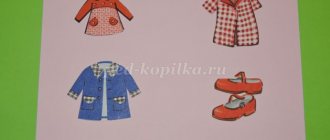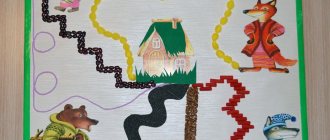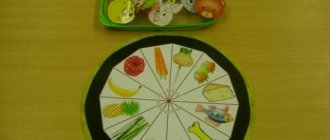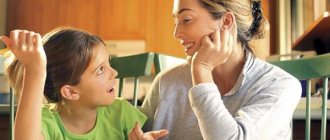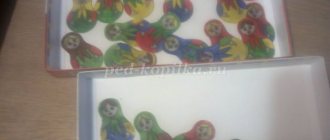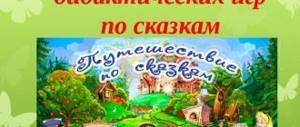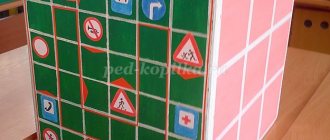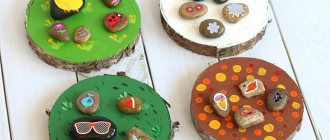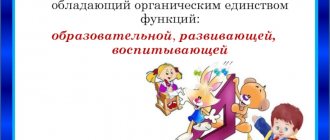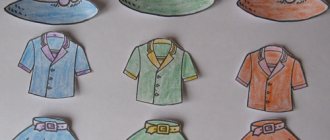Who creates a lapbook
A teacher can prepare the manual, but given the multifaceted nature of the topic being studied - “Professions of my family members”, “My ancestors”, “Family responsibilities”, etc. - parents and children take an active part in the preparation, namely in collecting information, design .
Starting from the second younger group, when completing a block of cards with professions, children select those that correspond to the specialty of their mothers and fathers. And in the senior/preparatory group, each child, together with his parents, prepares the “My Family Tree” project, which is included in the “Family History” block of materials.
Lapbooks are an important part of the design of the group’s subject-development environment
How to make a lapbook
The originality of the manual is determined, first of all, by the form of organization of the material, that is, the design. Typically, a solid base in the form of a folder, plastic envelopes for paper of different formats, and homemade paper envelopes for pockets for pictures, games, and coloring books are used for this. In addition, information with illustrations can be designed in the form of a chamomile flower. For example, in the first younger group, the material “Family Members” can be presented in this form: in the middle is the word “family”, from which “mom”, “dad”, “brother”, “sister”, “me”, “grandmother” extend as petals ", "grandfather", etc. For middle and senior preschool age, this could be a chamomile, illustrated with family photographs, with information about how they understand what family is (it is care, attention, love, etc.).
Among the ways to organize information there may be a glued-in accordion book. For example, you can present materials about professions to the middle group.
But if the form as a whole depends on the imagination of the lapbook author, then the content should be selected in accordance with the educational program and the requirements of the Federal State Educational Standard for children of a particular age.
Materials for the manual must be appropriate for the age of the children
Table: nuances of the content of the “My Family” lapbook blocks in different groups
| Block | Content | Features of lighting in different groups |
| Informational | This block presents new knowledge, expands vocabulary and determines the direction of the entire lapbook (help around the house, family members, professions, history, etc.). An information block can combine several topics. | In the first junior group, children are introduced to the concepts of “family” and “family members”. |
| In the second junior group, the information field is expanded by the concepts of “profession” and “ancestors”. | ||
| In the middle group, attention is focused on the role of everyone in the life of the family, including in performing household duties, and information about rights and responsibilities is included. | ||
| In the older group, information about famous relatives, history, and traditions of families is added. | ||
| In the preparatory group, a lapbook summarizes everything learned. The manual is designed to help children formulate the qualities of a happy family. | ||
| Fiction on the topic (fairy tales, stories) | Literary texts provide a figurative representation of the topic. Works are presented in the form of passages with questions about the text or a list of books recommended for reading. | The fairy tale “How a Bunny Hurt His Mother” for younger preschool children tells about the importance of a mother for a person. |
| In middle and high school, you can use texts and assignments for them from the book by A. Lopatina and M. Skrebtsova “Conversations and tales about the family for children and adults.” In the design of the literary part, you can use a selection of stories about the family of V. Sukhomlinsky. | ||
| Poems | They help update children’s existing knowledge on the topic, as well as consolidate what they have learned. | For kids, poems can be the basis of a block of information. For older children, this is more of a way to repeat what has been learned. |
| Puzzles | For younger groups, it is better to choose riddles with answers based on rhyme and use them to consolidate what they have learned. Although riddles for knowing the names of family members (mom, dad) can be given at the stage of introducing the topic. In the middle and senior groups, riddles can be grouped by subtopics: professions, names of family ties, family traditions, holidays (for example, Family Day, Love and Fidelity), etc. | |
| Visibility | Makes the manual bright, attractive for children, and is also used to illustrate a selection of material. A set of visual materials can include a video on the topic. | In younger groups there should be more pictures than text. They should be as large and bright as possible. |
| In the middle group, the pictures must be labeled; photographs of the pupils’ families can be included in the lapbook (with the task of telling about their family, which is a productive technique for developing coherent speech). | ||
| In the older group, the “My Family Tree” projects and children’s drawings on the topic are included in the visualization block. Children watch the videos and then discuss them. For example, what is told in the cartoon, how the characters behave, etc. In older groups, children can be asked to fantasize about what they would do in the situation in which the character finds himself. | ||
| Games | Games - didactic and active - are included in the lapbook in the form of a brief description of the conditions and a set of visual materials (cards, puzzles). | |
| Templates for coloring | They help to consolidate the material studied, repeat what has been covered, and develop imagination. | In the first younger group, children fix the names of colors on the “My Family” templates, in the second they learn to color without going beyond the boundaries of the image, in the older ones they learn to combine pencils, felt-tip pens, and paints in one coloring sheet. |
| Puzzles, crosswords | They are attracted to lapbooks for older preschoolers, since working with puzzles and crosswords requires knowledge of letters, as well as basic writing skills. Usually parents are involved in preparing this block. | |
Video: material for clarity - a selection of episodes of the cartoon “Barboskiny” about family values
Didactic game-lapbook (interactive folder) “Family”
Didactic game-lapbook (interactive folder) “Family”
Teacher, P.
One of the main principles of the Federal State Educational Standard for Education, paragraph 1.4, is “... introducing children to sociocultural norms, traditions of the family, society and state.” The Federal State Educational Standard for Preschool Education determines the content of the Basic Educational Program of Preschool Education. In the educational area “Socio-communicative development”, paragraph 2.6 talks about “... forming a respectful attitude and a sense of belonging to one’s family.” In this regard, modern teachers are looking for new effective effective means, forms, methods in their work that bring us closer to achieving the tasks assigned to them. One such teaching tool for today's preschoolers is the lapbook.
The “My Family” laptop helps the child to organize information on a topic at will, to better understand and remember the material. This is an excellent way to repeat information in individual work and for group classes. You can choose tasks that each child can do.
Relevance
In the modern material world, a sad trend is increasingly noticeable - people have begun to value family values less. Joint trips out of town, even Saturday lunches, contribute to rapprochement, identification of oneself as a family member, and can raise a child’s self-esteem when he realizes that at home he is not only fed, but is a place where he can share his experiences and new impressions. All this affects the formation of the child’s personality and contributes to its harmonious development. Therefore, strengthening the social value of the family becomes the basis of state family policy.
When analyzing the work, a problem was identified:
- children’s lack of sufficient knowledge about their family, lack of family traditions in the families of pupils, parents’ inability to build partnerships and trusting relationships with their children.
Expected results:
— Draw children’s attention to the history and traditions of their family.
— Reveal the creative talents of children and their parents.
— Dissemination of socially significant experience of family education.
— Motivating parents to preserve the traditions of their family.
— Increase the participation of parents in kindergarten activities.
Contents of the lapbook “Family”
"Family Portraits". Riddles about the family and its members. Goal: to consolidate children’s knowledge about the gender and age characteristics of people; name the distinctive features of a male and female face, young and old, the development of speech, mental abilities, visual perception, independence, and ingenuity.
"Family tree". Children draw figures of family members and stick them on Velcro. Goal: consolidation of knowledge about family ties, development of fine motor skills.
“Algorithm tell us about yourself” is a folding book. Goal: To teach children to write a story about themselves, give their first name, last name, address, height (tall, medium, short, age), describe their appearance, what members the family consists of, activities and hobbies in the family.
“Collect a proverb” Goal: to update children’s knowledge about folk proverbs about the family, develop attention, thinking, and coherent speech.
Didactic game “Dress up the doll.” Goal: consolidate the name of clothing items; develop the ability to distinguish between clothes for a boy doll and a girl doll.
Word game “Who does what?” represents a pocket containing cards with pictures. Goal: Development of coherent speech.
Pocket with educational cards on life safety “Home Alone” Purpose: To teach to follow the rules of safe behavior at home.
Didactic games “Whose thing is this?”, “Who loves what?”. Goal: to improve the grammatical structure of speech in children, to develop coherent speech.
Pocket “Finger games” Purpose: Development of fine motor skills, the ability to perform finger exercises by imitation and following verbal instructions. Train your child's memory.
Didactic games on the topic “Family”. For example: “Say the opposite” (hardworking brother - lazy sister, mother goes down - daughter goes up), “Compare - who is older, who is younger?” (mother-grandmother, grandfather-grandson).
Didactic game “Collect beads for mother and grandmother.” Goal: development of creative thinking, fine motor skills of the fingers.
“Find household appliances” Consolidate children’s knowledge about household appliances and their purposes, write mini-stories about them.
Didactic game “The dishes broke” Purpose: To teach children to form a whole from parts and continue to consolidate knowledge about the types of dishes.
In the pockets “Professions for Dad” and “Professions for Moms” there are cards with pictures of women’s and men’s professions. Goal: To expand and enrich children’s knowledge about the diversity of women’s and men’s professions.
Didactic game “My Cozy Home” Purpose: Continue to introduce children to the names of pieces of furniture, clarify the purpose of the furniture; learn to choose the right furniture for the furnishings of the selected room, be able to describe it.
Little books “The Secret of My Name.” In baby books, designed together with their parents, children talk about why their parents named them that name, the origin of their name, famous namesakes, etc.
The contents of the laptop can be expanded and complicated, and the materials included in the folder can change.
The “My Family” laptop is very popular among children! Everyone is interested, and the colorful design attracts children, makes them want to watch and play!
Materials for the lapbook “My Family”
Let's look at the selection of materials for different laptop blocks.
Information block
Text information is placed on the reverse side of the illustrations. For children 1.5–4 years old, these could be poems about family members:
- What a joy it is that there is a mother in the world. Her embrace is sweetness, Her smile is honor. Who in the world is the strongest? Who is taller and smarter than everyone else? This is daddy, of course, and everyone knows about it!
- My little sister has square diapers, colored rattles, and squeaky toys. She doesn’t speak yet, she screams loudly to the whole house. And she doesn't eat candy. Eh! Dairy diet!
- My brother is playing hide and seek. How can I understand him? He forgot to hide his heels, crawling under the bed. Then he climbed into the closet, But I have a question - How did the snub nose remain between the doors?
For children of middle preschool age, pictures with professions can be illustrated with a brief description:
- A doctor is a specialist who treats people and animals. Such people are also called doctors or physicians. The original meaning of the word “doctor” meant “exorcist, sorcerer.” Since ancient times, healers have been considered special people.
- A teacher is a person who teaches children at school. Ask your grandparents, dads and moms about their school teachers. You will be surprised to hear how well they remember them, even though they have been at school for a long time. After all, how can you forget those people who taught you to read and count, draw and sing, and much, much more. The teaching profession is one of the most ancient on earth. Even ancient people had to teach younger people and pass on their experience to them.
- Salesperson is the most popular profession of our time. People have been engaged in trading since time immemorial. At first there was a simple exchange of goods, but then people came up with money, and this simplified trade. The seller's predecessor was a merchant. Merchants, traveling all over the world, simultaneously bought, sold and exchanged goods. With the growth of the population, large stores began to appear and then a new profession appeared - salesman.
In the manual for senior preschool age, it is worth adding information about family etiquette and the responsibilities of family members:
- Family members should treat each other with respect, regardless of age.
- Household responsibilities should be divided as much as possible between all family members (father and mother buy groceries, children clean their room, help put things in the closet, etc.).
- Family members should consult with each other before making decisions that may affect the interests of others (for example, when buying a toy for your little brother, you should discuss with your parents how safe it will be for him).
Photo gallery: illustrations for the rules of family etiquette and household responsibilities
Children can unload laundry from the washing machine
Children can help wash dishes, for example, by putting them out to dry.
Children can hang out clean laundry
Pictures can illustrate some rules of family etiquette.
Family Traditions Calendar
This part of the information block includes a list of family traditions. In early preschool age, photos of children with family members during family hikes, celebrations, or thematic pictures are inserted into the appropriate pocket of an individual laptop, that is, prepared with parents. In the middle group, the photos are captioned, for example, “Grandma Lena’s birthday, date,” “Celebrating Maslenitsa,” etc. In the older group, in a common laptop for all, one card can be dedicated to each child: a general photo and a list of important dates for the family . Children take turns describing their traditions or talking about what each family has in common.
In the junior and middle groups, family traditions are covered in individual manuals
Nuances of designing an information block for older preschoolers
For a lapbook, which is compiled with parents on the basis of a family tree, you need to add information about prominent relatives, for example, about a great-grandfather who fought: the child talks about the prominent relative and shows the other children a photo.
A laptop based on a family tree turns out to be a kind of textbook on the history of the family
In addition, you can make a “photo sketch” “Who do I look like”, which the guys comment on, justifying this or that choice.
To create an identikit, you need to take several photographs of family members and cut them into strips according to facial features: forehead, eyes, lower part of the face, but not reaching the end of the card
Poems for children 5–7 years old
For children 4–7 years old, the selection could be like this:
- I look at the photo and proudly tell you: “Meet, here is my family. Here are dad, mom, cat and me. It’s impossible to live without them, My family is my friends!”
- Family is important, Family is cool, In the family, someone definitely needs you. Always take care and appreciate what you have. After all, if you break it, you won’t be able to glue it back together.
- A family begins with mom, dad and me, From the bustle of the house, From standing at the stove, From walks on days off, From fooling around with me, From the love of happy eyes And from pictures that are about us.
- I am proud of my family. Together we always do everything! A magical gift - friendship In my family - not service. Both in joy and in sorrow, At holidays and in the field, We are always all together, Adults and children. So we live together. We invite you to visit us!
Puzzles
For younger groups, the set could be like this:
- Who is the cutest in the world? Who do children love very much? I will answer the question directly: - Our dearest... (mother);
- Who can do difficult work on Saturdays? - With an axe, a saw, a shovel, ours builds and works... (father);
- Who never gets tired of loving, bakes pies for us, delicious pancakes? This is our... (grandmother).
For middle and senior preschool age, the selection can include:
- Everyone knows this word and wouldn’t trade it for anything! I’ll add “I” to the number “seven” - What happens? (Family);
- Who is the cheerful little one - crawling quickly on his belly? Amazing boy - This is my youngest... (brother);
- Mom’s older sister - She doesn’t look old at all, She asks with a smile: “How are you living?” Who came to visit us? (Aunt);
- You are probably familiar with him. He knows about all the laws. Not a judge, not a journalist. He gives advice to everyone... (lawyer);
- For an ambulance to rush across the bridge, it repairs at the bottom of the support. All day long, over and over again, he dives deep into the depths... (diver);
- A jack of all trades will sew us a jacket and trousers. Not a cutter, not a weaver. Who is she, tell me? (Dressmaker);
- Teaches us politeness, Reads a story out loud. Not a teacher, not a writer. This is a nanny,... (teacher);
- The bell rang loudly and the lesson began in the classroom. The student and the parent know - Will teach the lesson... (teacher).
Proverbs and sayings
In the middle and older groups, proverbs and sayings are included in the lapbook about the family:
- The whole family is together, and the soul is in place.
- Where there is harmony in the family, the children are raised well.
- The family is strong together.
- A family in a heap is not a terrible cloud.
- A family that agrees will not be overcome by grief.
- The house is full of children, and everyone is happy in it.
- Together it’s cramped, but apart it’s boring.
- The food tastes better at a communal table.
- For a grandson, grandfather is the mind, and grandmother is the soul.
Games
You can choose both didactic and outdoor games for the topic “My Family”. As for the latter, these can be folk games that are studied in the context of considering family traditions.
The block with outdoor folk games can be called “My Grandmother’s Games.”
The game block of the lapbook includes games that are in one way or another related to the theme “My Family”
Table: card index of games for the laptop “My Family”
| Name of the game | Rules | In which group can it be used? |
| Didactic games | ||
| "Guess who I'm talking about" |
| In the younger |
| "Ball of Magic Words" |
You can put a long woolen thread in a lapbook instead of a ball. | In all |
| "Fold the portrait" | Children take a set of strips and make up a portrait of one or another family member from them, then describe him. | In average |
| "Names Grow" |
| In middle, senior |
| "Present" |
| In older |
| The manual for primary and secondary preschool age also pays attention to finger games. | ||
| Outdoor games | ||
| "Run to Mom" |
| In the younger |
| "Confused" |
| In middle, senior |
Photo gallery: illustrations for the game “Gifts”
Computer glasses can be a gift for dad or grandfather
Dishes are given to mothers or grandmothers
Children must give reasons for choosing a particular gift.
An umbrella can be given to your mother, grandmother, or older sister.
Flowers can be given to mother, grandmother, aunt, sister
You can give the ball to your dad, brother or... yourself, if gifts have already been chosen for other family members
Photo gallery: coloring templates in the lapbook “My Family”
For young children, coloring books should be large, bright and with clearly expressed emotions on the faces of the characters.
Coloring book themes can be humorous
For coloring, you can use pictures with your favorite cartoon characters.
For older groups, coloring pages include more details than for younger groups
Before starting coloring, the teacher can ask the children to come up with a story based on the picture.
Lapbook “My Family”
Author:
Musina Zimfira Sayfullovna
teacher
MBDOU kindergarten "Snezhinka"
Khanty-Mansi Autonomous Okrug, Surgut district
At early preschool age, children begin to form elementary ideas about the phenomena of social life and the norms of human communication[1]. Children of this age are characterized by great emotional responsiveness, which allows them to cultivate love, good feelings and relationships towards people around them and, above all, towards loved ones, towards their family. This is the basis of moral and patriotic education[2].
This year I decided to create a lapbook “My Family”, in which the children’s parents actively took part.
The purpose of my work is to introduce children to family members, their hobbies, family traditions and values, and relationships in their lives.
Tasks:
— expand the idea of the family through the organization of different types of activities;
- cultivate love and respect for family members;
- introducing the child to the nearest society - getting to know the family, the history of the family, and the traditions of the family.
The laptop is a homemade interactive thematic folder, with pockets and games according to age.
Figure 1 shows my finished work.
Each game is divided into pockets:
— Didactic games: “Story pictures”, “Cut-out pictures”, “Granny’s rug”, “Family portrait”, “Assemble a house”;
- finger games.
Also, children and their parents took an active part in creating the family tree and photo album “Family”
Such an unusual, bright, colorful, entertaining and accessible folder will definitely attract the attention of children and parents. What will contribute to the development of memory, attention, observation and bringing the family closer to joint creative activity.
BIBLIOGRAPHY
1. Bure R.S. Toolkit. Social and moral education of preschool children (3-7 years old), 2020.
2. Veraksa N.E., Komarova T.S., Vasilyeva M.A. Basic educational program of preschool education “From birth to school”, Moscow-2016.
“Certificate of publication in the media” Series A No. 0004990
We invite teachers of preschool education in the Tyumen region, Yamal-Nenets Autonomous Okrug and Khanty-Mansi Autonomous Okrug-Yugra to publish their teaching materials: - Pedagogical experience, original programs, teaching aids, presentations for classes, electronic games; — Personally developed notes and scenarios of educational activities, projects, master classes (including videos), forms of work with families and teachers.
Why is it profitable to publish with us?
1. 1. “Kindergartens of the Tyumen Region” is an officially registered specialized media outlet at the federal level. 2. The activities of the editorial office are supported by the Department of Education and Science of the Tyumen Region 3. We issue a “Certificate of Publication” in the media. 4. The document has a unique number, is entered in the register, has the original seal of the editorial office of the online publication and signature. 5. “Certificate of publication” in the media is sent to the author in both paper and electronic versions. In detail In detail >>> Sample “Certificate of publication of author’s methodological material in the media”.pdf
Share
Options for using a laptop
The manual is unique in that you can work with it both in a kindergarten and at home. The usage vectors will be identical:
- to get acquainted with the topic (for example, in early preschool age - with the concept of “family”);
- for practical comprehension of acquired knowledge in games, memorization of poems, coloring on the topic;
- for organizing independent work of preschoolers.
In kindergarten, a laptop can be used as the basis for organizing work in a general lesson on a topic: at the updating stage, children solve riddles, remember poems on the topic, at the main stage of the lesson they write descriptions of pictures, play, and at the final stage they color the picture and/or solve puzzles , Crosswords.
Children work with a lapbook both individually and in pairs and mini-groups
